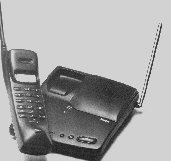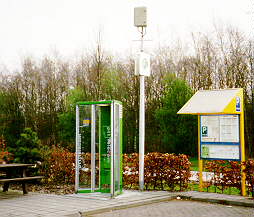
Cordless Phones
|
|

Start page of video from Short Course
by BMRC
Video from Wireless Communications Networks Short Course
"The main difference between cordless and cellular is that in a cellular system, the
operator provides a service which is very similar to a normal telephony
service except that you can be anywhere where you want whereas in cordless what the
operator provides is simply a wireline telephone link to your house. And there you have a small personal "base station" so you can walk around your house with a direct link to your own
base station. But there is no provision for taking your cordless phone to another city and
placing a call there. ... ."
|

Embedded QuickTime Video
| | |

By 1997, more than 60 per cent of the U.S. home telephones were cordless. A similarly high peneration is achieved in
some south-east Asian markets.
Penetration in Europe is lagging, but double digit growth
is predicted by several analysts.
History
- The need for cordless was not recognized by regulatory agencies in Europe, but the scale of illegal imports from the U.S. and Asia forced action.
- CT0
- CT1
- CT2 (marketed to home user)
- DECT (marketed as wireless PBX)
- Integrated into PCN / PCS
Some countries also have CT.0, which uses much cheaper technology that CT.1 or CT.2. CT.0
can not be used for wireless office telephony, and does not support encryption. CT1 only has coverage near the user's private
"base"
station.
Expectations are that DECT will dominate the cordless market,
at least in Europe, after the turn of the century.
Sales of 20 million units will amount to 60% of the market.
Cordless Telephone CT2

- Frequency Division
Multiple Access
("Each conversation has its own frequency")
- Carrier Spacing 100 kHz
- Time Division Duplex, with 2 msec frame
duration
- Channel rate 72 kbit/s
- Binary Frequency Shift Keying
- Speech coding: Adaptive Differential PCM at
32 kbit/s
- 0.72 bit/s/Hz
- provides access to PSTN (Telepoint, Netherlands PTT
Telecom: Kermit / Greenpoint)
- can not receive calls, but can be combined
with paging service
- Can be used for fax
- Use with data modems: officially announced max 2400 bit/s, but
can work better.
Using indoor antennas, CT1 and and CT2 typically have a range of 100 meters. With outdoor antennas
this can be increased to about 500 meters.
Digital Enhanced Cordless Telephone










